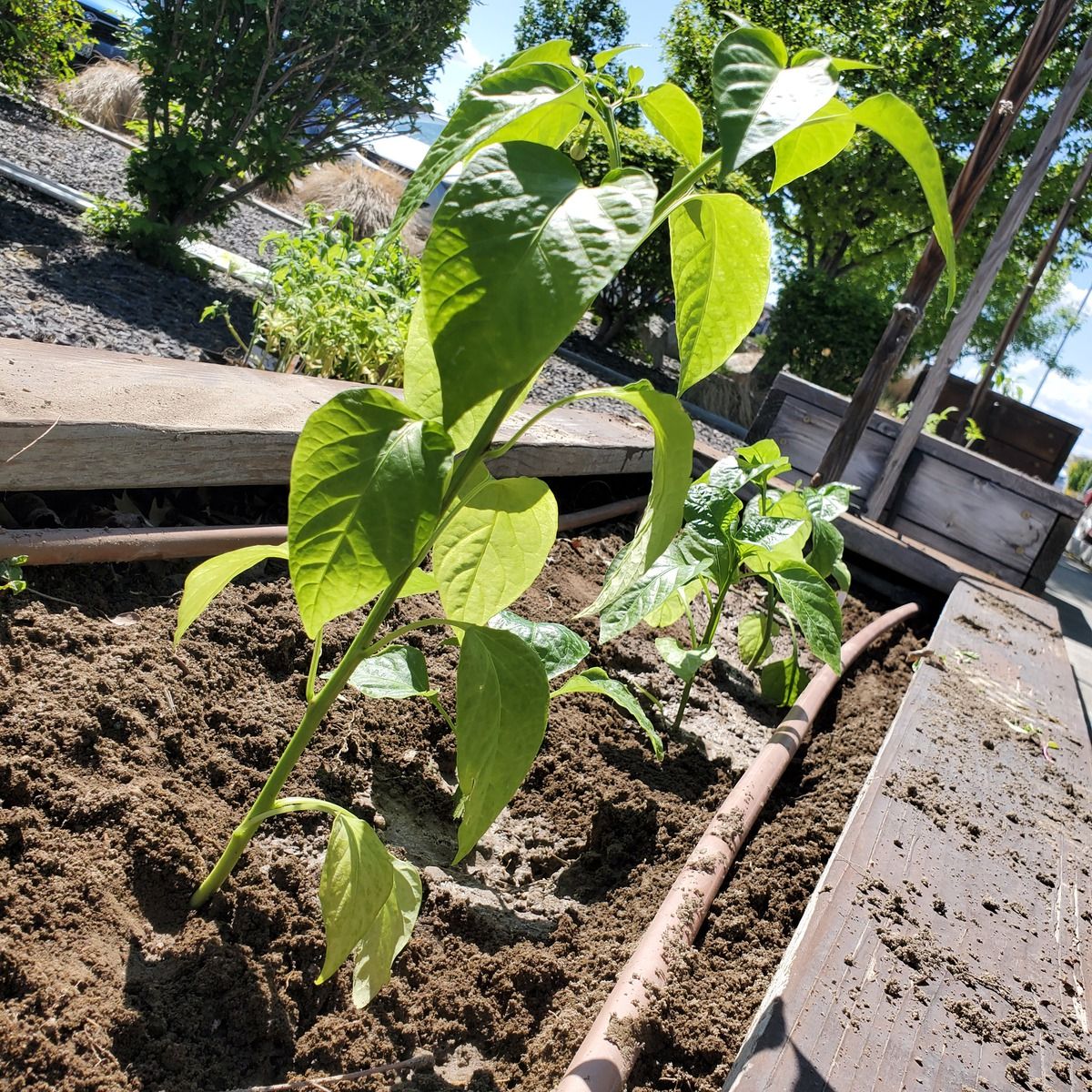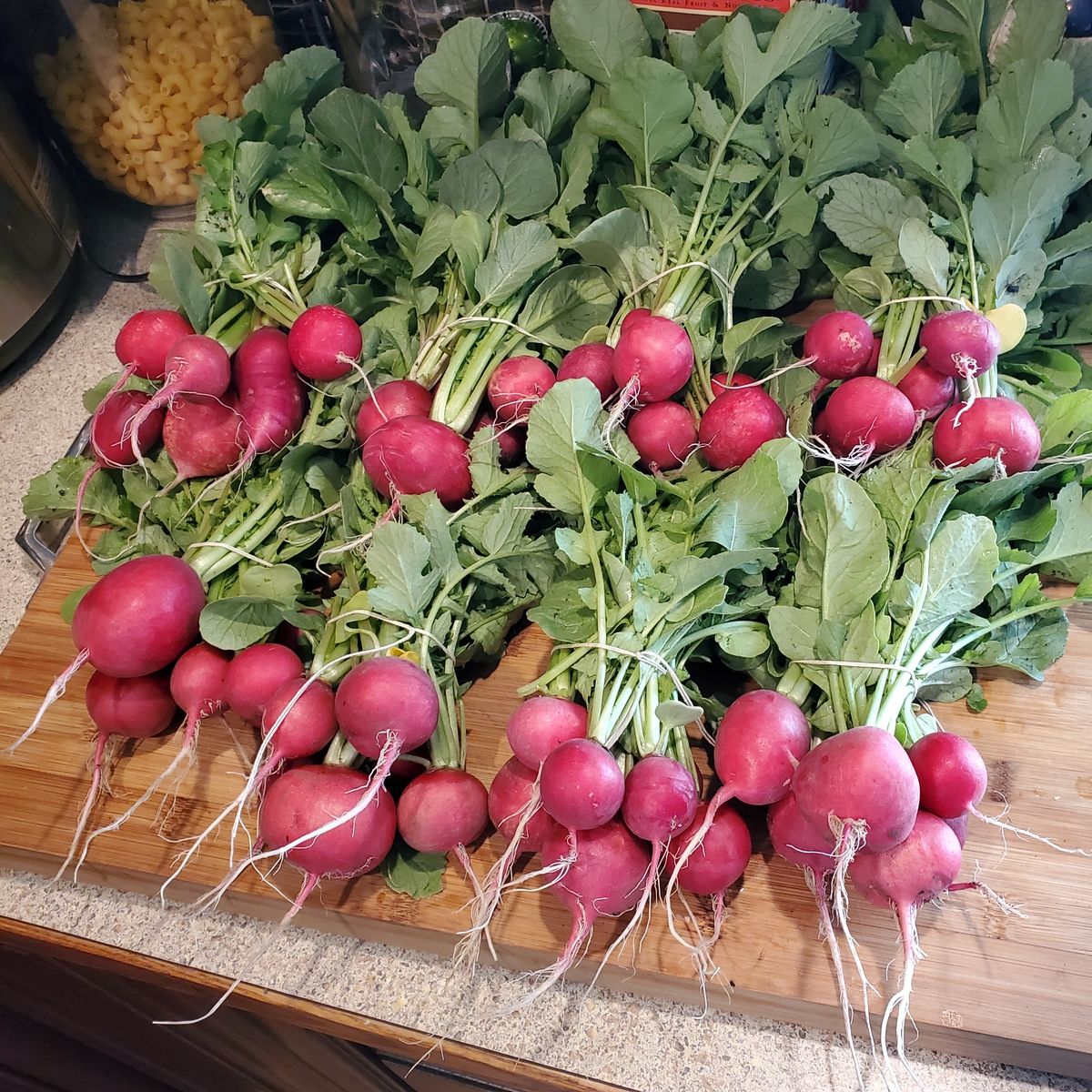Plants are in the ground! The plants I started indoors have been hardened off to survive the transition to living outside. The radishes I planted in the kiddie pool have done well; I re-seeded for another batch of them. I genuinely love radishes since they’re easy to grow, one of the first veggies you can seed outside, and you can eat the whole plant, leaves and all!
But the main thing everyone likes to grow is tomatoes, and I’m no different. They are an amazing plant; discussing them lets you touch on so many topics! When they’re smaller and you’re transplanting them, you can bury tomatoes deeply, or even sideways, since all the hairs along the stem can turn into roots. When they’re flowering, they have a heat intolerance during the flowering stage — a particular issue in our location. Above 85–90°F, the pollen of a tomato plant will become tacky and difficult to disperse, which means it’s easy to miss the season if the tomatoes aren’t ready to pollinate before it gets too hot out. To combat this, one of my Master Gardener friends strings shade cloth — the kind you might find for a deck cover — above her tomato plants when it begins to heat up.
"Under- or over-watering, or even just irregular watering, can prevent the plant from moving calcium from the soil to the fruit."
The other difficulty in cultivating tomatoes is blossom-end rot, which happens when the tomato rots on the vine, forming a leathery brown patch on the blossom end that can destroy all the tomatoes on the plant. It is caused by calcium deficiency, which can occur due to multiple factors. Rarely does the soil actually need more calcium; more often than not, it’s a watering issue. Under- or over-watering, or even just irregular watering, can prevent the plant from moving calcium from the soil to the fruit. Calcium deficiency can also occur when the dirt is over-fertilized, resulting in an excess of nitrogen. Nitrogen promotes leaf growth, so any available calcium is pulled into the leaves — not into the tomatoes. Crushed eggshells are an excellent source of calcium for plants, but they will take at least one to two years to break down enough for plants to use. It’s not bad for the soil while the shells decompose, but if you need calcium right away, other forms are available to the plants sooner. Lime provides calcium, and Dolomite Lime also adds magnesium. Both of those increase the pH of the soil, though, so it's important to keep that in mind. Bone meal is a great way to go, as it adds calcium and some phosphorus.

The most important consideration is consistent watering. After several long conversations with different gardeners, I invested in a watering system for my plots in the ground. There are many systems, each with successful gardeners who prefer them. I was told to watch out for spray heads with fine holes; they can easily get clogged by the hard water we tend to have in this region. If you google ‘micro sprayer heads’, you can find small cheap heads in blue, green, and red (90-, 180-, and 360-degree spray radius), which are pretty cheap in bulk online.
"The most important consideration is consistent watering."
To install the spray heads, you’ll need tubing (I got mine from KIE) which you lay down in the middle of the garden bed, poking holes where you need the sprayers. After placing the tubing, screw the spray heads in, and that’s it! If you make a mistake in the placement or want to rearrange things, you can get goof plugs. Just pop them into the ‘mistake’ holes and try again! The initial investment in a watering system — the connector pieces, the T and L pieces, and a timer — wasn’t impossible to budget for, but it’s more expensive than hand watering.
The issue with hand watering is consistency, whereas a timer system provides even and consistent watering, maximizing the ability of your plants to move nutrients. It also saves time if your space is larger, meaning you can spend more time weeding and managing the space. Not to mention, you can set the watering time to earlier than you’re typically up so the ground can fully absorb the water before the morning sun evaporates it away!
If you didn’t get any plants started in May, it’s not too late for veggies this year; we have a fall crop season that you can plan for! Parsnips and rutabagas need around 100 days of preparation before planting (I’m planning on mine being ready in late October). Besides those, we’ll also have another round of lettuces that can grow after the high heat of the summer passes, not to mention the easy-to-build hoop houses that allow you to harvest certain things even into December. It’s not too late to try!
Please write to me and let me know what you're growing, what your setup is like, any tips or tricks you’d like to share, or really anything. I love talking to people about gardening!
Randy McNiven is a local nonprofit chef learning to grow food! https://blackapronwa.com/ and Instagram: @food4everyonetc
A local nonprofit chef learning to grow food! https://www.instagram.com/food4everyonetc/and https://www.instagram.com/blackapronwa/


